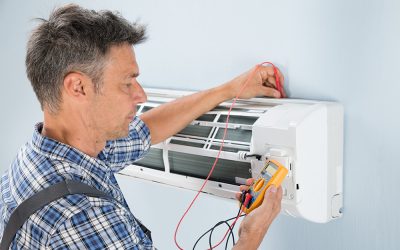The quality of the air you breathe in your home, at work or at school can have a significant impact on your health. Poor indoor air quality can be directly linked to issues like trouble concentrating, fatigue, headaches, asthma attacks and irritation of the lungs, eyes, nose and throat. Contaminants in indoor air can trigger allergic reactions and lead to a variety of illnesses. If the contaminants in the air inside a structure include asbestos, radon or carbon monoxide, it can wreck havoc on the health of the people who frequent those buildings and lead to cancer, or even death, over a period of time.
A Serious Problem
The Environmental Protection Agency reports that the poor quality of indoor air in homes, workplaces, schools and other buildings is among the top five environmental health risks. According to the EPA, there is almost five times as much pollution in indoor air as there is in the air outdoors. The agency pointed out that the air in some indoor areas they have tested, there was as much as 100 times more pollutants compared to the outdoors. And people young and old breathe in these pollutants every day. It’s not surprising that a growing number of people are developing allergies and respiratory illnesses.

Common Contaminants In Indoor Air
Many people are not aware that the indoor air they breathe in the buildings they live in, work at, and frequent, contains a wide array of contaminants. Some of the contaminants commonly found in indoor air include:
- Mold and Mildew
- Pet Dander
- Dust and Dust Mites
- Viruses and Bacteria
- Tobacco Smoke
- Pollen
- Pesticides
- Lead
- Formaldehyde
- Microplastics
- Colognes, Perfumes and Air Fresheners
- Smoke and other pollutants from stoves, fireplaces, chimneys and heaters
- Toxic chemicals like methylene chloride, benzene and perchloroethylene found in paints, insect spray and household cleaners
That means the average person may be breathing in a toxic mix of polluted indoor air that goes directly into their lungs, then their bloodstream and to all the organs and cells in their body and brain. Over time, breathing polluted indoor air can lead to a wide array of illnesses, particularly in the very young, the very old and people with compromised immune systems.

Indoor Air Pollution
Indoor air pollution can be insidious. The average person doesn’t realize the air quality in their homes, jobs and schools is poor because the pollutants it contains are largely odorless. They assume because they don’t see any particulate matter or smell foul or unusual odors in the indoor air they breathe, it’s clean and safe. That is a dangerous assumption. Many of the dangerous pollutants indoor air contains is invisible to the naked eye. The only clue the indoor air is dirty is when you and your loved ones begin to cough, sneeze and wheeze and regularly suffer with nasal and sinus congestion, sore throats and conditions like asthma and Rhinitis. Still, many people never realize it’s the polluted indoor air that’s making them sick.
Air Quality Testing
The only way to be sure the air quality in your home, business, school or any other building, is good and safe is to do indoor air quality testing. The process is fast, simple and affordable, yet it can be one of the most important steps you can take to protect the health and quality of life of you and your loved ones. You can get a trusted company with experienced, highly-trained staff and state of the art instruments to conduct the air quality tests, provide you with the results, and suggest a number of ways you can improve the quality of the air in your home, business or any other building.
Air Quality Near Me
Many people say ‘The air quality near me is fine’ and they believe that’s true, but having the quality of the air tested in their home and the places they frequent may have them singing a new tune… one that goes, ‘I thought the air quality near me was good until I had it tested.’ Most people do not realize the air they breathe regularly is very dirty until they have it thoroughly tested by licensed, competent, experienced professionals. When the test results are revealed, most people are shocked when they see how much pollution they are breathing in on a daily basis.
A Surprising Source Of Pollution
Most people understand the dangers asbestos, radon and carbon monoxide pose to their health and the quality of their indoor air, and will quickly take action to get rid of them; but, many people have carpeting in their homes and businesses and do not realize it can be a major culprit when it comes to polluting indoor air. Carpet fibers and the adhesives and other chemicals used to install it can release dangerous pollutants into the air.
To protect the quality of your indoor air, request the carpet installer use low-emitting adhesives, unroll the carpet in an area that’s well-ventilated and air it out before installation. Consider scheduling the installation when most people are not present. Open the doors and windows and/or use room air conditioners, window fans and other mechanical ventilation equipment to force the fumes outside. Keep the area well ventilated for two to three days after installing new carpet.
Causes Of Poor Quality Indoor Air
Several factors can negatively impact the quality of the indoor air in a building. One of them is poor ventilation. The following are some signs your building lacks proper ventilation:
- Indoor air smells stale or stuffy
- Windows and walls have moisture condensation
- Moldy shoes, books, and/or other items
- Dirty HVAC equipment
Problems controlling temperature and having the humidity be too high or too low can cause bacteria, viruses, mold and mildew to thrive and hurt the air quality in a building. The dust from recent remodeling projects or construction in the building can pollute the indoor air and lower its quality. Other activities taking place in or near your home or office can prevent sufficient fresh air from getting inside, and lower the quality of the indoor air. Environmental factors, airborne chemicals, natural gasses leaking in and poor construction materials can all have a negative impact on the air quality in a building.

DIY Methods For Improving The Quality of Indoor Air
There are some simple steps you can take to improve indoor air quality.
Use a dehumidifier to keep humidity under 50%. This can reduce moisture in the air and help limit the spread of bacteria and viruses.
Regularly replace the heater and vent filters in your home or office.
Replace carpets with hard flooring if possible or vacuum the carpets twice a week and call in a professional to clean it regularly. If you have pets, vacuum your floors frequently to get rid of pet dander and replace your air filters every month.
To prevent exposure to mold and mildew, repair leaks right away, keep your carpets and flooring dry and make sure your home or business is properly ventilated.
Call In The Professionals
Sometimes even the most earnest DIY efforts of the owner isn’t enough to get the quality of the indoor air in a building to healthy levels. In that case, you should call in a trusted company to perform indoor air quality testing, identify the contaminants polluting the air and install an air purifier to remove the pollutants and improve the air quality.



